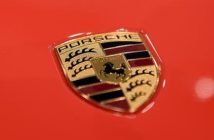+++ Every vehicle in BMW ’s range will be offered with an electrified variant by the time 2020 ticks around but the company is remaining confident that these models won’t undermine its goal of creating the ultimate driving machines. BMW Group chief executive Harald Kruger recently told that there is no conflict between the electrification of its range and the brand’s driving experience and excellent chassis dynamics. He says that given the boost in performance which electrification can provide, it will add another element of driving pleasure. Although the brand will offer numerous battery-electric, hybrid and plug-in hybrid models by 2020, it doesn’t see these vehicles accounting for more than 20 percent of its sales until beyond 2025. When that time comes, hydrogen fuel-cell cars will be added to its range, likely starting with the firm’s largest and most luxurious models. Alongside adopting the latest technology in electrification, BMW will extend its autonomous driving systems throughout its fleet and doesn’t expect these features to detract from its models either. In fact, development chief Klaus Fröhlich recently said: “It’s not fun to drive in heavy traffic. It’s not fun to be in a dense area and try to find parking. These autonomous abilities will be an option for the driver to choose, not the only mode. Our drivers will always have a choice, and our architectures can do both. It’s not rocket science. It’s not so difficult”. +++
+++ BUGATTI Chiron production is being stepped up next year as the waiting list for new orders has eclipsed more than 3 years before any customers have even test driven the new hypercar. The Bugatti Veyron replacement was unveiled at the 2016 Geneva motor show and more than 200 orders have now been placed. The Chiron has 1500 hp, can reach 100 km/h in less than 2,5 seconds, despite weighing 1.995 kg, and has a maximum top speed of 420 km/h. It costs 2.4 million euro plus taxes. “Demand has been incredible and these are not the kind of customers who like to wait too long for a new car”, said Bugatti boss Wolfgang Dürheimer. “We will step production up next year to bring the wait down, but there is only so much we can do. Traditionally, we have manufactured one car a week. Next year, the total for the year will be around 65”. Drives for potential customers will begin next March, and Dürheimer anticipates the full production run of 500 standard Chirons selling out shortly afterwards. “We have many prospects who are keen to know more and wavering on putting down a deposit. My feeling is that after driving the car, most will buy one”. The largest order of Chirons by a single individual is 6. It was placed by a customer who was buying a car for himself and as gifts for other members of his family. Dürheimer stressed that even in such circumstances, the company cannot offer a discount, reasoning that it will sell the cars at full price regardless. Dürheimer also played down talk of a second Bugatti model line. The firm has investigated several concepts in recent years, including showing the Bugatti Galibier saloon concept. However, the fallout from the Dieselgate crisis and the new focus on investing in electric cars at Volkswagen, which owns Bugatti, has reportedly made the business case for fringe products harder to justify. +++
+++ German carmaker DAIMLER is to become this year’s biggest and most profitable luxury car maker, its chief executive said. “We will achieve it this year, 4 years ahead of time”, Daimler CEO Dieter Zetsche said, referring to the company’s 2020 target of becoming the world’s biggest premium carmaker. The company had announced the goal in 2011 and Zetsche said back then everyone was laughing at the announcement. Daimler’s passenger car unit Mercedes Benz was on track for full-year sales of more than 2 million cars, Zetsche said, putting it ahead of rivals Audi and BMW. +++
+++ According to a report hot off the press, the new-age JEEP Grand Wagoneer has been placed on hold for unconfirmed reasons. Two Jeep supplier sources said that the luxurious, three-row SUV may not hit the market until next decade. It is thought that one reason for the brand to push back the launch of the model is that it simply doesn’t have the money to develop at the moment. Jeep’s parent company, Fiat Chrysler Automobiles, has begun a rapid expansion with an onslaught of new models, including the Alfa Romeo Giulia and Stelvio. Additionally, a new Ram 1500 pickup truck is being developed, the Jeep Wrangler updated and a Wranger-based pickup on the cards. Additionally, it is reported that the cost to retool the brand’s Warren Truck Assembly Plant for a new Grand Wagoneer could be immense, perhaps too expensive if Jeep wants the model to rival offerings from Range Rover, Bentley and Mercedes-Benz. There are also concerns about whether using a stretched version of the Grand Cherokee’s platform, as planned by FCA, is a good idea if the company wants to maximize interior space and comfort without sacrificing on and off-roading abilities. +++
+++ A new range-topping LEXUS LS will be launched at the Detroit motor show in January before going on sale in 2018. It’ll then be launched with the option of hydrogen power in 2019, as the firm looks to capitalise on the leadership in fuel cell technology established by the Toyota Mirai of its parent company. Lexus’s rival to the Audi A8, BMW 7 Series, Jaguar XJ and Mercedes-Benz S-Class will be based heavily on the LF-FC concept car that was unveiled at the Tokyo motor show in 2015. The LS is also expected to be sold with the choice of a V8 hybrid powertrain producing around 550 hp. Lexus Europe boss Alain Uyttenhoven said: “We know how to make fuel cells and the only challenge is how to package a fuel cell in a car that also needs a certain level of performance”. He did not confirm plans for the LS, however. “Premium buyers have certain expectations. For refinement, fuel cell is ideal, but we must also do some work to demonstrate the right levels of performance”. The hydrogen-powered LF-FC concept had one electric motor driving the rear wheels, with electricity being sent to two in-wheel electric motors at the front. Its drive system allowed it to precisely distribute torque to all four wheels, resulting in “exceptional dynamic handling and superior road stability”. In addition, placing the power control unit at the front and hydrogen storage tanks in a ‘T’ configuration were said to allow for “optimal” weight distribution for a sports saloon. The LF-FC also had 2 driving modes. In Cruising mode, the fuel cell stack drew on hydrogen and created electricity to drive the motor and recharge the battery. In Acceleration mode, both the battery and the fuel cell stack powered the car’s main electric motor and its in-wheel electric motors for maximum power. The new LS – which is expected to go on sale with conventional powertrains in 2018 – is expected to be a technological showpiece for Lexus, with several autonomous driving functions, a new-look interior that includes front and rear touchscreens and features such as a gesture-controlled infotainment system. It will be based on the new Lexus GA-L platform, which will first be used on the new Lexus LC500 and LC500h sports cars. The spread of hydrogen fuel stations is expected to grow exponentially by 2019, but reports suggest Lexus has still predicted that hydrogen-powered versions of the LS will sell “in hundreds, not thousands” and sales will be targeted in large cities such as London, Los Angeles, Paris and Tokyo, where diesel is expected to be outlawed by 2020. +++
+++ Germany is investigating whether Volkswagen’s sportscar brand PORSCHE used software to disguise exhaust emissions, the country’s car industry regulator said, in a fresh blow to Volkswagen’s attempts to move on from a 15 month-old scandal. The investigation could be particularly embarrassing for Volkswagen Group chief executive Matthias Müller, who headed the Porsche brand prior to getting the top job. Germany’s Motor Transport Authority, KBA, said it was examining software to see whether it could measure the angle of a car’s steering wheel. At stake is whether Porsche used software to detect whether its cars were being subjected to laboratory tests, using this information to switch to a less polluting emissions pattern than would occur under normal driving conditions. The KBA is already conducting a similar investigation into Volkswagen ’s Audi brand, which supplies diesel engines to Porsche. A Porsche spokesman said steering wheel movements were not used to detect whether a car was undergoing an emissions test. “This is not done with any Porsche models”, the spokesman said, adding Porsche was fully cooperating with the KBA. Volkswagen was not immediately available to comment. Volkswagen admitted in September 2015 to using illegal “defeat device” software in the United States to disguise the true level of toxic emissions from diesel engines, sparking the biggest business crisis in its history. It has agreed a multi-billion dollar settlement with U.S. authorities and is spending billions more to refit vehicles and speed up development of electric cars. +++
+++ RUSSIAN car sales recorded their first monthly rise in almost 2 years in November, the Association of European Businesses (AEB) lobby group said, though it added it was too early to say the market had turned a corner. After a decade of annual sales growth in excess of 10 percent, Russia’s car industry has become one of the most high-profile victims of an economic crisis fuelled by lower oil prices and Western sanctions over Moscow’s actions in Ukraine.
New car sales in November rose 0.6 percent year on year – or by 727 sold units – to 132,346 vehicles, after a 2.6 percent drop in the previous month. “It is far too early to read a trend turnaround into this”, said Jörg Schreiber, Chairman of the AEB Automobile Manufacturers Committee. December is expected to prove whether the market “continues to move in the right direction”, Schreiber added in a statement. Car sales fell 12 percent year-on-year in January-November to 1.28 million units, the AEB said. The AEB has said it expected Russian sales of new cars and light commercial vehicles to fall 10.3 percent to 1.44 million units in 2016. +++
+++ The 2017 SEAT Ibiza will go on sale in July following a world debut sometime in the spring, most likely at the Geneva motor show in March. Seat has been particularly coy with the new model, and development cars have only been spotted wearing heavy cladding or disguises – the most recent was seen wearing camouflage to make it look like a Hyundai i20. Despite the covers, it was clear this test mule is running new tail-lights that look to have taken influence from the units used on the larger Leon. Similar changes appear to have been applied to the headlights, too, suggesting the Ibiza will share several design features with its larger sibling. The future Ibiza is also expected to get a more premium cabin to make the model feel more upmarket, and it looks to have grown in size, too, suggesting there will be more space for passengers. This supports inside information that says the 2017 Ibiza will be the first car to use the Volkswagen Group’s upcoming MQB A Zero architecture, which is expected to make better use of space and also underpin future versions of the Volkswagen Polo and Skoda Fabia. The bulk of the next Ibiza range will use the Volkswagen Group’s latest turbocharged four-cylinder petrol and diesel engines, with a smaller 1.0-litre three-cylinder unit being retained. The next-generation Ibiza will also spawn a crossover version later in its life, to sit below the Ateca SUV and offer a Seat alternative to the Audi Q2. Unlike the Q2, however, the Ibiza crossover isn’t expected to get a four-wheel-drive option, making do with front-wheel drive only. It’ll be slightly longer and taller than the hatch, and feature bulky wheel arches and a more youthful design. +++
+++ While SKODA is still discussing the possibility of launching in the United States, its parent company, Volkswagen, says such a move would be suicidal. A senior Volkswagen board member recently told that such an idea is absolutely mad and makes no sense. “We may be crazy, but we’re not mad. Entering this huge market with an unknown brand, a model range focused on Europe, and a non-existent dealer network is pure suicide. Furthermore, the last thing Volkswagen of America needs now is in-house cannibalization”, they said. Without the approval of its German overlords, Skoda has no chance of making its way stateside and will instead remain primarily focused on the European market. Certainly the brand’s most important new model is the Kodiaq SUV, its first player into such a market and pivotal in helping it to capture some of the burgeoning demand for crossover and SUV models around the world. Although deliveries of the Kodiaq have yet to commence, it has already been confirmed that a coupe variant will debut at the Shanghai Auto Show next year. +++


